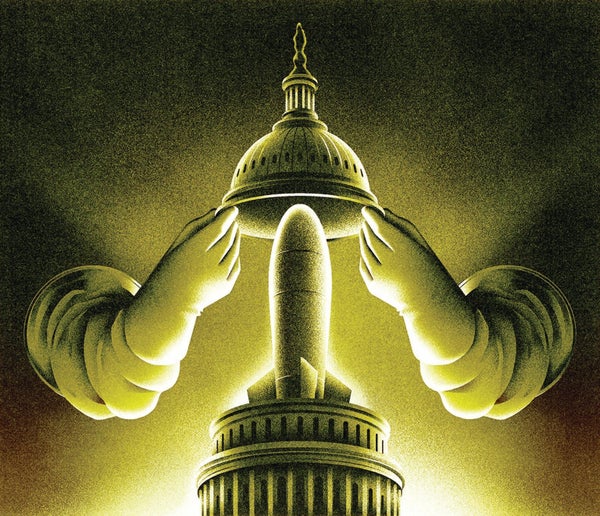This article is part of “The New Nuclear Age,” a special report on a $1.5-trillion effort to remake the American nuclear arsenal.
The U.S. is planning to modernize its unwanted, unneeded and unsafe nuclear triad of land-, sea- and air-based weapons. Perfectly poised to refight the cold war, these overhauled bombs will waste $1.5 trillion and threaten life on Earth for the century to come. We should rethink this miserable folly rather than once again squandering our wealth while driving a new arms race.
As detailed in this issue of Scientific American, this plan to burn money while imperiling the world has been widely criticized in nuclear policy circles. “Russia and the United States have already been through one nuclear arms race. We spent trillions of dollars and took incredible risks in a misguided quest for security,” former U.S. defense secretary William J. Perry wrote in 2016 as the plans first materialized. “There is only one way to win an arms race: refuse to run.”
Although the Biden administration canceled proposed Trump-era sea-launched missiles, the U.S. nuclear arsenal still bristles with some 3,700 weapons, around 1,700 of them deployed for military use and the rest in storage overseen by the Department of Energy. This quantity is more than enough to threaten the destruction of humanity and Earth's biosphere—and it is only a fraction of the world's total, leaving out Russia's similarly large stockpile and smaller ones in China and other nations. Lowering the numbers and thus the risks of these weapons is a responsibility the U.S. and the Soviet Union first recognized at the end of the 1960s, and this goal should drive military and political decision-making now.
Instead the U.S. is sleepwalking into an ill-considered and little-discussed resurrection of its three-pronged cold war nuclear forces. Meanwhile China is expanding its own arsenal (to one-fourth the size of the U.S.'s). New submarines, missiles and planes, all designed to fit into a military strategy first conceived before the death of Joseph Stalin in 1953, will by 2050 leave the dead hand of the past steering us into another century of pointless risks. In this future, a mistake or misjudgment could exterminate humanity, as nearly happened repeatedly throughout the cold war. We are simply fortunate, nothing more, to have survived the hundreds of false alarms that rang over those decades.
At the center of the government's proposal is a $100-billion bid to fill 450 nuclear silos in five inland states with hundreds of new nuclear missiles set to launch on hair triggers. Built before submarine-launched missiles became large, accurate and untraceable, these relics are now justified as a “nuclear sponge” to absorb a Russian attack on the U.S. Why plant a $100-billion nuclear “kick me” sign on the country's breadbasket?
We cannot store the nuclear waste we have now, never mind the additional waste that will result from building these missiles. The so-called nuclear sponging mapped in this month’s issue [see “Sacrifice Zones”] would kill up to several million from radiation exposure, with hundreds of millions in North America being at risk of exposure to lethal fallout. Even a limited nuclear war between India and Pakistan would kill tens of millions worldwide and cause global famine—but how can the U.S. argue for other nations to disarm while burnishing its own nuclear sword in such a heedless fashion?
We aimed this Damoclean sword at ourselves during the cold war when we produced 70,000 of the plutonium “pits” that trigger thermonuclear warhead explosions. Weapons tests of these blasts have left every part of Earth's surface contaminated with plutonium, with hotspots such as the Rocky Flats in Colorado and the Hanford sites in Washington State still requiring tens of billions of dollars for cleanup. Faltering efforts to restart pit production for the nuclear-modernization effort have cost $18 billion to $24 billion, much of it wasted, and, by the admission of weapons officials at Los Alamos National Laboratory in New Mexico, they don't even seem to be immediately necessary.
Why are we risking so much when the lessons of the 20th century are so clear? In the words of the 1991 START Treaty that capped the cold war, “nuclear war would have devastating consequences for all humanity ... it cannot be won and must never be fought.” Disregarding Russia's inability to turn its nuclear arsenal to military advantage while being bombarded by Ukrainian drones, our political class has fumbled away hard-won wisdom about the deadly futility of the arms race. We are recapitulating the dangers the world turned away from decades ago.
Who today benefits from disinterring the arms race? Only defense-industry shareholders and military contractors near silos in North Dakota, Montana, Wyoming, Colorado and Nebraska. This, in a nation where we have just doubled child poverty out of a refusal to help lower-income families. Surely it would be cheaper, safer and smarter to build factories or universities or research labs in these places, construct low-cost housing next to new engineering or biomedical campuses there, and watch them boom, in a good way, for the next century at a fraction of the silo-overhaul price tag. The 900 nuclear missiles onboard U.S. submarines will meanwhile deter the feared nuclear first strike the obsolescent land missiles were meant to discourage at the dawn of the cold war.
“A worrisome new arms race is brewing,” United Nations secretary-general António Guterres said in September. “This is madness. We must reverse course.” We agree. The only real way to use nuclear weapons is never. They should exist only in numbers large enough to deter their use by others, which they already abundantly do, with not one warhead more.
